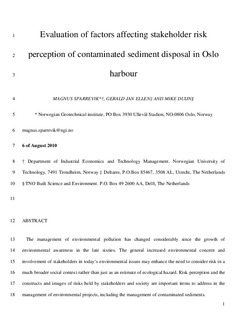| dc.contributor.author | Sparrevik, Lars Magnus | |
| dc.contributor.author | Ellen, Gerald Jan | |
| dc.contributor.author | Duijn, Mike | |
| dc.date.accessioned | 2017-11-01T13:06:26Z | |
| dc.date.available | 2017-11-01T13:06:26Z | |
| dc.date.created | 2010-09-27T03:08:05Z | |
| dc.date.issued | 2011 | |
| dc.identifier.citation | Environmental Science and Technology. 2011, 45 (1), 118-124. | |
| dc.identifier.issn | 0013-936X | |
| dc.identifier.uri | http://hdl.handle.net/11250/2463458 | |
| dc.description.abstract | The management of environmental pollution has changed considerably since the growth of environmental awareness in the late 1960s. The general increased environmental concern and involvement of stakeholders in today's environmental issues may enhance the need to consider risk in a much broader social context rather than just as an estimate of ecological hazard. Risk perception and the constructs and images of risks held by stakeholders and society are important items to address in the management of environmental projects, including the management of contaminated sediments. Here we present a retrospective case study that evaluates factors affecting stakeholder risk perception of contaminated sediment disposal that occurred during a remediation project in Oslo harbor, Norway. The choice to dispose dredged contaminated sediments in a confined aquatic disposal (CAD) site rather than at a land disposal site has received a lot of societal attention, attracted large media coverage, and caused many public discussions. A mixed method approach is used to investigate how risk perceptive affective factors (PAF), socio-demographic aspects, and participatory aspects have influenced the various stakeholders' preferences for the two different disposal options. Risk perceptive factors such as transparency in the decision making process and controllability of the disposal options have been identified as important for risk perception. The results of the study also support the view that there is no sharp distinction in risk perception between experts and other parties and emphasizes the importance of addressing risk perceptive affective factors in similar environmental decision-making processes. Indeed, PAFs such as transparency, openness, and information are fundamental to address in sensitive environmental decisions, such as sediment disposal alternatives, in order to progress to more technical questions such as the controllability and safety. | |
| dc.language.iso | eng | |
| dc.title | Evaluation of factors affecting stakeholder risk perception of contaminated sediment disposal in Oslo harbour | |
| dc.type | Peer reviewed | |
| dc.type | Journal article | |
| dc.description.version | acceptedVersion | |
| dc.source.pagenumber | 118-124 | |
| dc.source.volume | 45 | |
| dc.source.journal | Environmental Science and Technology | |
| dc.source.issue | 1 | |
| dc.identifier.doi | 10.1021/es100444t | |
| dc.identifier.cristin | 349722 | |
| dc.relation.project | Norges forskningsråd: 188946 | |
| cristin.unitcode | 7452,0,0,0 | |
| cristin.unitname | Norges Geotekniske Institutt | |
| cristin.ispublished | true | |
| cristin.fulltext | postprint | |
| cristin.qualitycode | 2 | |
